Automated Building Height Estimation Using Ice, Cloud, and Land Elevation Satellite 2 Light Detection and Ranging Data and Building Footprints
Abstract
1. Introduction
2. Materials and Methods
2.1. Study Area
2.2. Data
2.2.1. ICESat-2/ATLAS
2.2.2. Building Footprints NYC
2.2.3. Landcover Raster Data (2010)
2.2.4. World Settlements Footprint (2019)
2.2.5. Digital Elevation Model (DEM)
2.2.6. Test Data
2.3. Methods
2.3.1. Preliminary Denoising
2.3.2. Extracting Building Photons and Ground Photons
- i.
- The height of ground photons may not reflect the true base-level height (net ground surface) of the building, leading to discrepancies in building height measurements (Figure 3a). For instance, ground photons may fall on vegetation, depression, or other artificial or natural objects, resulting in a building height that is either lower or higher than the actual building height.
- ii.
- Laser photons may not hit the highest point of the building, resulting in an inaccurate measurement of the building height (Figure 3b).
- iii.
- Building photons that fall on the edge of the building’s contour may not necessarily be located on the building itself (Figure 3c).
- iv.
- Discrepancies in building height measurements can arise due to mismatches between date of building construction, photon acquisition time, and building ground measurement time (Figure 3d). For example, if a building is under construction during field measurement but completed by the time the point cloud is acquired, the height recorded in the point cloud may be greater than the height measured on-site.
- v.
- Other issues include errors in manual data processing of building footprint data (Figure 3e).
- (1)
- Filtering ground photons
- Sifting ground photons using landcover raster data to remove points that fell on tree canopy, grass/shrub, and other paved surfaces.
- Applying a density-based radius filtering method with a range of 5 m and at least 3 supporting photons within this range to remove outliers while retaining useful information.
- Calculating the height difference between adjacent photons along the track direction to remove abnormal ground relief. If the absolute value of the height difference between photon t and its next photon was greater than h meters (Formula (1), |∆Ht| > h), the position of the photon t was considered the starting point of terrain relief. Along the track direction, when photon t + n encountered an absolute value of height difference greater than h meters again (Formula (2), |∆Ht+n| > h), the position of the photon t + n was considered as the end point of terrain relief. The distance (D, Formula (4)) between photon t and photon t + n and the height difference between photon t and photon t + n (∆H, Formula (3)) were calculated. If the absolute value of the height difference was less than n meters and the distance was less than m meters (|∆H| < m, D < d), the terrain relief was considered abnormal, and all photons between photon t and photon t + n were removed (Formula (5)).
- t: the index of the t-th photon along the track;
- t + n: the index of the (t + n)-th photon along the track;
- Ht: the height of the t-th photon;
- ∆Ht: the height difference between the t-th and (t − 1)-th photons along the track;
- ∆H: the height difference between the (t + n)-th and t-th photons along the track;
- Xt: the abscissa of the t-th photon under the UTM projection;
- Yt: the ordinate of the t-th photon under the UTM projection;
- D: the Euclidean distance between the t-th and (t + n)-th photons along the track;
- h, m, and d: constant variable.
- (2)
- Filtering building photons
- (3)
- Building height estimation
2.3.3. Accuracy Evaluation
- HATL03: estimated building heights based on ATL03 data;
- HO: observed building height;
- n: number of variables.
2.4. Parameter Sensitivity Analysis
2.5. Analysis of the Influence of Building Number and Building Height Estimation Accuracy
- Analysis based on New York City’s boroughs: We analyzed the relation between building number and estimation accuracy within each borough.
- Mixed analysis of all New York City boroughs: In each iteration, a fixed number of buildings were selected from each district for the purpose of spatially representativeness, and they were aggregated together to compute an overall accuracy.
3. Results and Discussion
3.1. Building Height Estimation
3.2. The Instability of Model Parameters
3.2.1. Parameters of Ground Photon Screening
3.2.2. Parameters of Building Photon Screening
3.2.3. Variable Sensitivity Analysis
3.3. The Expansibility Analysis of the Model
3.4. Comparing to Existing Method of Building Height Based on ICESat-2 Data
3.5. Limitations and Further Work
- (1)
- Replacing the building footprint data with Microsoft Bing Maps, which offers global building footprint data (excluding China) and can be accessed at https://github.com/microsoft/GlobalMLBuildingFootprints (accessed on 1 December 2023).
- (2)
- To construct comprehensive and detailed datasets, it is essential to integrate multiple data sources. Consider the following points:
- Integration of multi-spectral data: This involves incorporating data from various sources such as Landsat, Sentinel, Moderate-Resolution Imaging Spectroradiometer (MODIS), and others. By leveraging the spatial, spectral, or temporal information present in multispectral images, it is possible to build more comprehensive and detailed datasets. Additionally, the fusion of multispectral or hyperspectral image data with LiDAR data enables the creation of datasets that capture changes in building height over time.
- Utilization of advanced machine-learning or deep-learning techniques: The application of techniques like convolutional neural networks (CNN) or recurrent neural networks (RNN) can significantly enhance the classification accuracy of the algorithms. These techniques excel in extracting features efficiently and recognizing patterns. Employing them can greatly improve the effectiveness of the dataset creation process.
4. Conclusions
- (1)
- Consideration of the spatial relationships between buildings and photons. By incorporating the spatial relationships between photons and buildings, ground, and other objects, we enhance the classification accuracy of both ground photons and building photons. The inclusion of spatial context and the use of a self-adaptive buffer for building photon selection improve the confidence of building photon identification. This comprehensive approach leads to improved accuracy in building height estimation;
- (2)
- Good performance in New York City. The proposed method was successfully applied to estimate the heights of 17,399 buildings in New York City, achieving an RMSE of 8.1 m. Moreover, approximately 71% of the buildings exhibited an absolute difference of less than 3 m, demonstrating the effectiveness of our approach in a complex urban environment;
- (3)
- Strong robustness in varied conditions. The method demonstrated suitability for retrieving building heights under diverse conditions; its effectiveness can be extended to various geographical contexts.
Author Contributions
Funding
Data Availability Statement
Conflicts of Interest
Appendix A



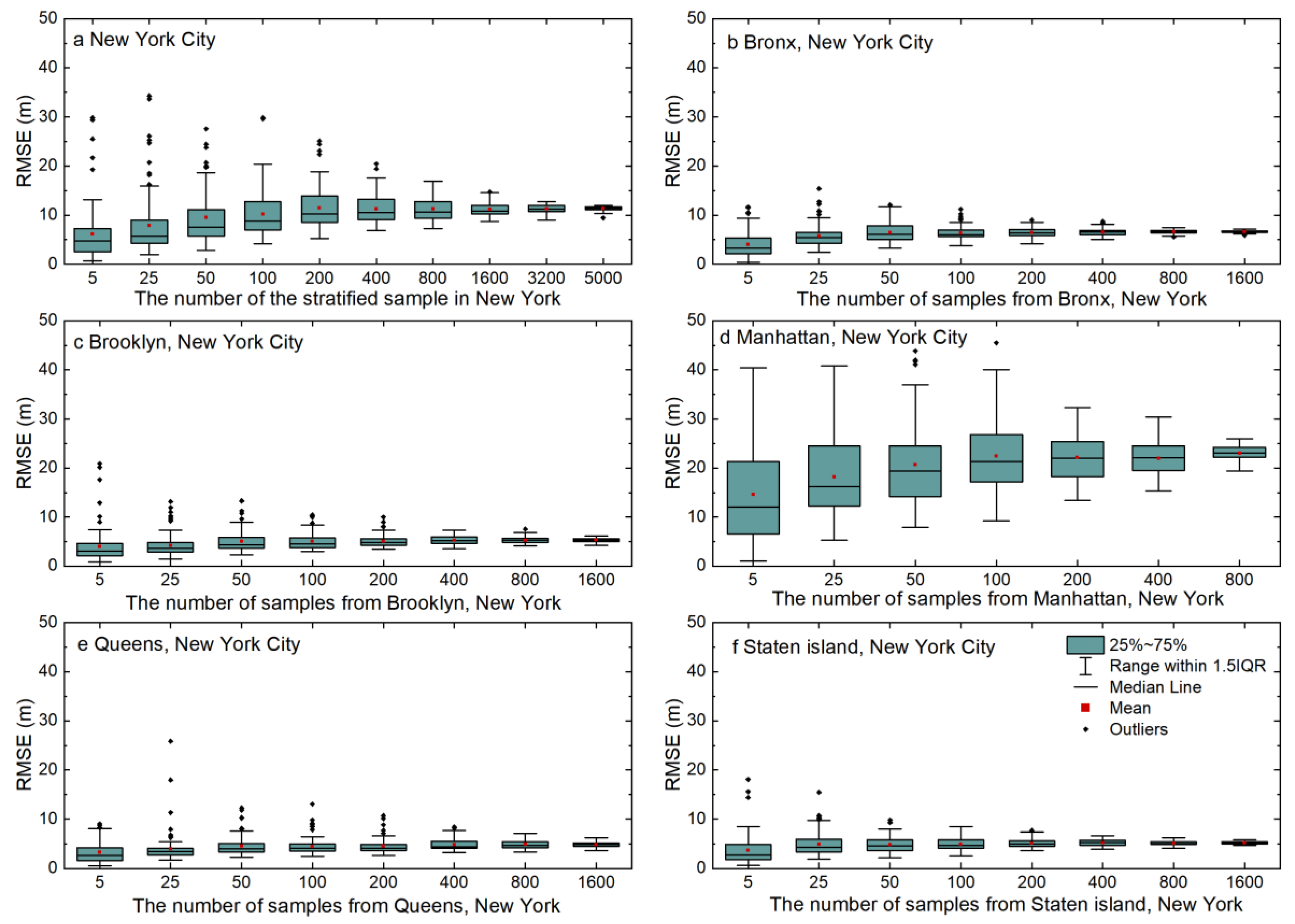
| Study | Study Area | The Number of Buildings | Reference Sources | Precision |
|---|---|---|---|---|
| This study | New York, USA | 17,399 | BuildingFootprints NYC | RMSE = 8.1 m, MAE = 3 m |
| Lao’s study [35] | Haidian, Beijing, China | 75 | The field measurement used Rigel VZ-1000 laser scanning system | RMSE = 0.35–0.45 m |
| Dandabathula’s study [40] | Jaipur city, India | 10 | The field measurement used zero-elastic carpenter’s thread (scientific grade) | MAE = 0.13 m |
| Goud and Bhardwaj’s study [41] | Hyderabad, Paris and Vancouver | 30 | Determined the number of floors for each sample building utilizing Google Images and Google Earth Pro | RMSE = 2.04 m |
| Wu and Zhao’s study [48] | Wujiaochang in the Yangpu District of Shanghai, China | 468 | The Digital Surface Model (DSM) data provided by Shanghai Surveying and Mapping Institute | RMSE = 6.75 m, MAE = 4.70 m |
| Wu and Zhao’s study [21] | The city center of Shanghai, China | 1176 | The Digital Surface Model (DSM) data provided by Shanghai Surveying and Mapping Institute | RMSE = 3.23 m, MAE = 2.33 m |
References
- United Nations Environment Programme. Global Status Report for Buildings and Construction: Towards a Zero-Emission, Efficient and Resilient Buildings and Construction Sector; United Nations Environment Programme: Nairobi, Kenya, 2020. [Google Scholar]
- Horowitz, C.A. Paris Agreement. Int. Leg. Mater. 2016, 55, 740–755. [Google Scholar] [CrossRef]
- Borck, R. Will skyscrapers save the planet? Building height limits and urban greenhouse gas emissions. Reg. Sci. Urban. Econ. 2016, 58, 13–25. [Google Scholar] [CrossRef]
- Glaeser, E.L.; Kahn, M.E. The greenness of cities: Carbon dioxide emissions and urban development. J. Urban. Econ. 2010, 67, 404–418. [Google Scholar] [CrossRef]
- Li, M.; Koks, E.; Taubenböck, H.; van Vliet, J. Continental-scale mapping and analysis of 3D building structure. Remote Sens. Environ. 2020, 245, 111859. [Google Scholar] [CrossRef]
- Kim, T.-Y.; Han, G.-S.; Kang, B.-S.; Lee, K.-H. Development of a risk assessment model against disasters in high-rise buildings and results of a building simulation analysis. J. Asian Arch. Build. Eng. 2022, 21, 249–262. [Google Scholar] [CrossRef]
- Kumar, A. Review of building regulations for safety against hazards in Indian hill towns. J. Urban. Manag. 2018, 7, 97–110. [Google Scholar] [CrossRef]
- Wu, T.; Perrings, C.; Kinzig, A.; Collins, J.; Minteer, B.; Daszak, P. Economic growth, urbanization, globalization, and the risks of emerging infectious diseases in China: A review. Ambio 2016, 46, 18–29. [Google Scholar] [CrossRef]
- Du, Y.; Mak, C.M.; Tang, B.-S. Effects of building height and porosity on pedestrian level wind comfort in a high-density urban built environment. Build. Simul. 2018, 11, 1215–1228. [Google Scholar] [CrossRef]
- Boo, G.; Darin, E.; Leasure, D.R.; Dooley, C.A.; Chamberlain, H.R.; Lázár, A.N.; Tschirhart, K.; Sinai, C.; Hoff, N.A.; Fuller, T.; et al. High-resolution population estimation using household survey data and building footprints. Nat. Commun. 2022, 13, 1330. [Google Scholar] [CrossRef]
- Langford, M.; Higgs, G.; Radcliffe, J.; White, S. Urban population distribution models and service accessibility estimation. Comput. Environ. Urban. Syst. 2008, 32, 66–80. [Google Scholar] [CrossRef]
- Alahmadi, M.; Atkinson, P.; Martin, D. Estimating the spatial distribution of the population of Riyadh, Saudi Arabia using remotely sensed built land cover and height data. Comput. Environ. Urban. Syst. 2013, 41, 167–176. [Google Scholar] [CrossRef]
- Oke, T.R. City size and the urban heat island. Atmos. Environ. 1973, 7, 769–779. [Google Scholar] [CrossRef]
- Khandelwal, S.; Goyal, R.; Kaul, N.; Mathew, A. Assessment of land surface temperature variation due to change in elevation of area surrounding Jaipur, India. Egypt. J. Remote Sens. Space Sci. 2018, 21, 87–94. [Google Scholar] [CrossRef]
- Salvati, L.; Zitti, M.; Sateriano, A. Changes in city vertical profile as an indicator of sprawl: Evidence from a Mediterranean urban region. Habitat. Int. 2013, 38, 119–125. [Google Scholar] [CrossRef]
- Goetz, M. Towards generating highly detailed 3D CityGML models from OpenStreetMap. Int. J. Geogr. Inf. Sci. 2013, 27, 845–865. [Google Scholar] [CrossRef]
- OpenStreetMap. OpenStreetMap. Available online: https://www.openstreetmap.org/#map=5/38.007/-95.844 (accessed on 1 December 2023).
- Biljecki, F.; Ledoux, H.; Stoter, J. Generating 3D city models without elevation data. Comput. Environ. Urban. Syst. 2017, 64, 1–18. [Google Scholar] [CrossRef]
- Zhou, J.; Luo, C.; Jiang, W.; Yu, X.; Wang, P. Using UAVs and robotic total stations in determining height differences when crossing obstacles. Measurement 2022, 188, 110372. [Google Scholar] [CrossRef]
- Abdulrahman, F.; Zaia, Y.; Gilyane, S. Height Evaluation and Linear Accuracy of Digital Level, Total station, GPS and Orthophoto. Acad. J. Nawroz Univ. 2018, 7, 27. [Google Scholar] [CrossRef]
- Zhao, Y.; Wu, B.; Li, Q.; Yang, L.; Fan, H.; Wu, J.; Yu, B. Combining ICESat-2 photons and Google Earth Satellite images for building height extraction. Int. J. Appl. Earth Obs. Geoinf. 2023, 117, 103213. [Google Scholar] [CrossRef]
- Park, Y.; Guldmann, J.-M. Creating 3D city models with building footprints and LIDAR point cloud classification: A machine learning approach. Comput. Environ. Urban. Syst. 2019, 75, 76–89. [Google Scholar] [CrossRef]
- Sun, Y.; Mou, L.; Wang, Y.; Montazeri, S.; Zhu, X.X. Large-scale building height retrieval from single SAR imagery based on bounding box regression networks. ISPRS J. Photogramm. Remote Sens. 2022, 184, 79–95. [Google Scholar] [CrossRef]
- Frantz, D.; Schug, F.; Okujeni, A.; Navacchi, C.; Wagner, W.; van der Linden, S.; Hostert, P. National-scale mapping of building height using Sentinel-1 and Sentinel-2 time series. Remote Sens. Environ. 2021, 252, 112–128. [Google Scholar] [CrossRef]
- Brunner, D.; Lemoine, G.; Bruzzone, L.; Greidanus, H. Building Height Retrieval From VHR SAR Imagery Based on an Iterative Simulation and Matching Technique. IEEE Trans. Geosci. Remote Sens. 2010, 48, 1487–1504. [Google Scholar] [CrossRef]
- Li, X.; Zhou, Y.; Gong, P.; Seto, K.C.; Clinton, N. Developing a method to estimate building height from Sentinel-1 data. Remote Sens. Environ. 2020, 240, 111705. [Google Scholar] [CrossRef]
- Cao, Y.; Huang, X. A deep learning method for building height estimation using high-resolution multi-view imagery over urban areas: A case study of 42 Chinese cities. Remote Sens. Environ. 2021, 264, 112590. [Google Scholar] [CrossRef]
- Yang, C.; Zhao, S. A building height dataset across China in 2017 estimated by the spatially-informed approach. Sci. Data 2022, 9, 76. [Google Scholar] [CrossRef]
- Huang, H.; Chen, P.; Xu, X.; Liu, C.; Wang, J.; Liu, C.; Clinton, N.; Gong, P. Estimating building height in China from ALOS AW3D30. ISPRS J. Photogramm. Remote Sens. 2022, 185, 146–157. [Google Scholar] [CrossRef]
- Misra, P.; Avtar, R.; Takeuchi, W. Comparison of Digital Building Height Models Extracted from AW3D, TanDEM-X, ASTER, and SRTM Digital Surface Models over Yangon City. Remote Sens. 2018, 10, 2008. [Google Scholar] [CrossRef]
- Bonczak, B.; Kontokosta, C.E. Large-scale parameterization of 3D building morphology in complex urban landscapes using aerial LiDAR and city administrative data. Comput. Environ. Urban. Syst. 2019, 73, 126–142. [Google Scholar] [CrossRef]
- Cheng, F.; Wang, C.; Wang, J.; Tang, F.; Xi, X. Trend analysis of building height and total floor space in Beijing, China using ICESat/GLAS data. Int. J. Remote Sens. 2011, 32, 8823–8835. [Google Scholar] [CrossRef]
- Yang, X.; Wang, C.; Xi, X.; Wang, P.; Lei, Z.; Ma, W.; Nie, S. Extraction of Multiple Building Heights Using ICESat/GLAS Full-Waveform Data Assisted by Optical Imagery. IEEE Geosci. Remote Sens. Lett. 2019, 16, 1914–1918. [Google Scholar] [CrossRef]
- Seidleck, M. The ice, cloud, and land elevation satellite-2—Overview, science, and applications. In Proceedings of the 2018 IEEE Aerospace Conference, Big Sky, MT, USA, 3–10 March 2018; pp. 1–8. [Google Scholar]
- Lao, J.; Wang, C.; Zhu, X.; Xi, X.; Nie, S.; Wang, J.; Cheng, F.; Zhou, G. Retrieving building height in urban areas using ICESat-2 photon-counting LiDAR data. Int. J. Appl. Earth Obs. Geoinf. 2021, 104, 102596. [Google Scholar] [CrossRef]
- Han, L.; Li, L.; Chen, H. Evaluation of the Significant Wave Height from HY2B/ALT Using Cryosat2/SIRAL and ICESAT2/ATLAS Data Sets in the Arctic. In Proceedings of the International Geoscience and Remote Sensing Symposium (IGARSS), Brussels, Belgium, 11–16 July 2021; pp. 7572–7575. [Google Scholar]
- Ma, X.; Zheng, G.; Chi, X.; Yang, L.; Geng, Q.; Li, J.; Qiao, Y. Mapping fine-scale building heights in urban agglomeration with spaceborne lidar. Remote Sens. Environ. 2023, 285, 113392. [Google Scholar] [CrossRef]
- Liu, A.; Cheng, X.; Chen, Z. Performance evaluation of GEDI and ICESat-2 laser altimeter data for terrain and canopy height retrievals. Remote Sens. Environ. 2021, 264, 112571. [Google Scholar] [CrossRef]
- Xie, J.; Huang, G.; Liu, R.; Zhao, C.; Dai, J.; Jin, T.; Mo, F.; Zhen, Y.; Xi, S.; Tang, H.; et al. Design and Data Processing of China’s First Spaceborne Laser Altimeter System for Earth Observation: GaoFen-7. IEEE J. Sel. Top. Appl. Earth Obs. Remote Sens. 2020, 13, 1034–1044. [Google Scholar] [CrossRef]
- Dandabathula, G.; Sitiraju, S.R.; Jha, C.S. Retrieval of building heights from ICESat-2 photon data and evaluation with field measurements. Environ. Res. Inf. Sustain. 2021, 1, 011003. [Google Scholar] [CrossRef]
- Goud, G.P.S.; Bhardwaj, A. Estimation of Building Heights and DEM Accuracy Assessment Using ICESat-2 Data Products. Eng. Proc. 2021, 10, 37. [Google Scholar] [CrossRef]
- U.S. Census Bureau. Measuring America’s People, Places, and Economy. Available online: https://www.census.gov/quickfacts/fact/table/newyorkcitynewyork,bostoncitymassachusetts,US/LND110210 (accessed on 1 December 2023).
- Statista Research Department. Real Gross Domestic Product of New York in the United States from 2000 to 2022. Available online: https://www.statista.com/statistics/188087/gdp-of-the-us-federal-state-of-new-york-since-1997/#statisticContainer (accessed on 1 December 2023).
- Neumann, T.A.; Martino, A.J.; Markus, T.; Bae, S.; Bock, M.R.; Brenner, A.C.; Brunt, K.M.; Cavanaugh, J.; Fernandes, S.T.; Hancock, D.W.; et al. The Ice, Cloud, and Land Elevation Satellite—2 mission: A global geolocated photon product derived from the Advanced Topographic Laser Altimeter System. Remote Sens. Environ. 2019, 233, 111325. [Google Scholar] [CrossRef]
- Hawker, L.; Uhe, P.; Paulo, L.; Sosa, J.; Savage, J.; Sampson, C.; Neal, J. A 30 m global map of elevation with forests and buildings removed. Environ. Res. Lett. 2022, 17, 024016. [Google Scholar] [CrossRef]
- Karra, K.; Kontgis, C.; Statman-Weil, Z.; Mazzariello, J.C.; Mathis, M.; Brumby, S.P. Global land use/land cover with Sentinel 2 and deep learning. In Proceedings of the 2021 IEEE International Geoscience and Remote Sensing Symposium IGARSS, Brussels, Belgium, 11–16 July 2021; pp. 4704–4707. [Google Scholar]
- Neumann, T.A.; Brenner, A.; Hancock, D.; Robbins, J.; Saba, J.; Harbeck, K.; Gibbons, A.; Lee, J.; Luthcke, S.B.; Rebold, T. ATLAS/ICESat-2 L2A Global Geolocated Photon Data, Version 5; NASA National Snow and Ice Data Center Distributed Active Archive Center: Boulder, CO, USA, 2021. [Google Scholar] [CrossRef]
- Wu, B.; Huang, H.; Zhao, Y. Utilizing Building Offset and Shadow to Retrieve Urban Building Heights with ICESat-2 Photons. Remote Sens. 2023, 15, 3786. [Google Scholar] [CrossRef]
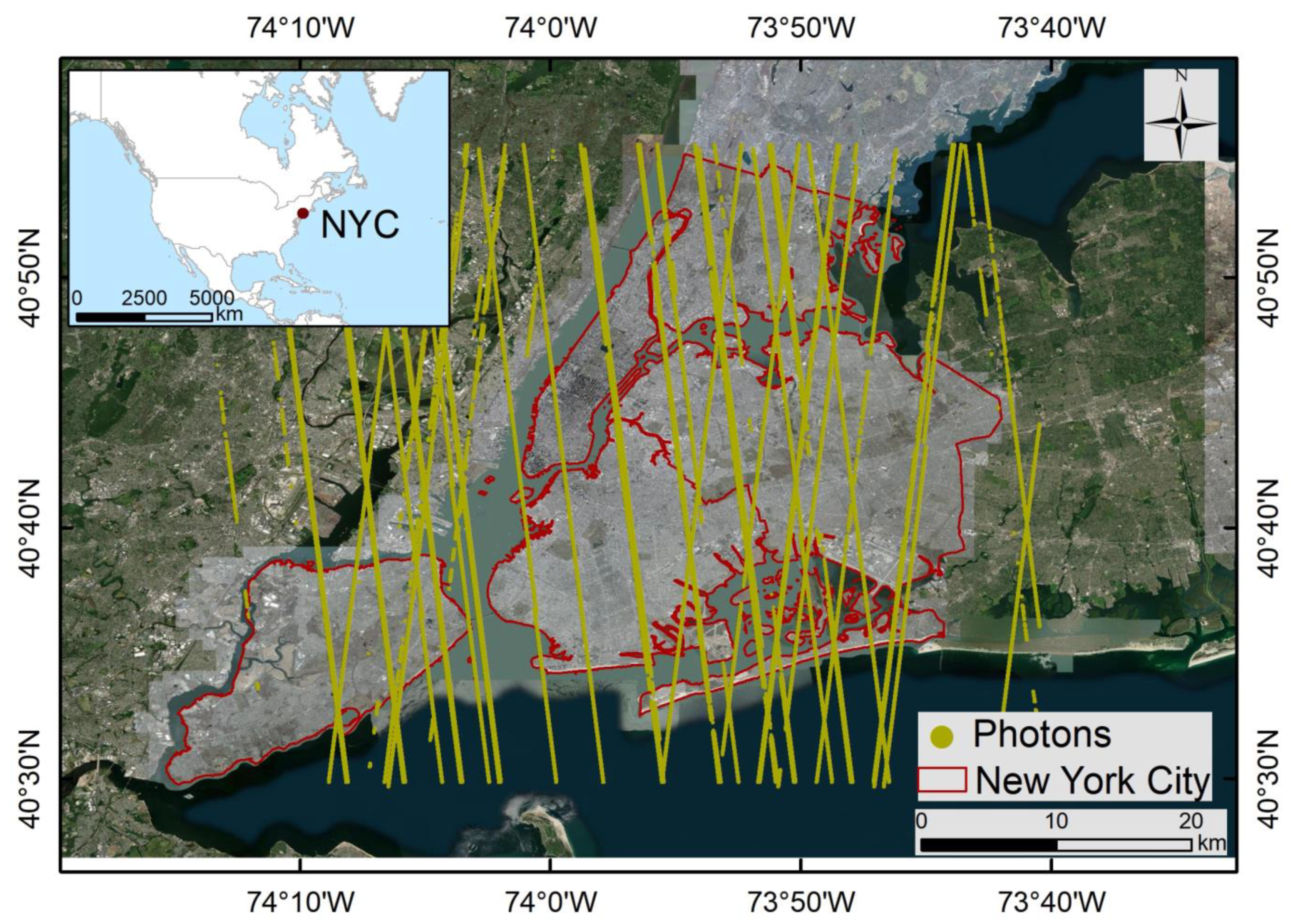
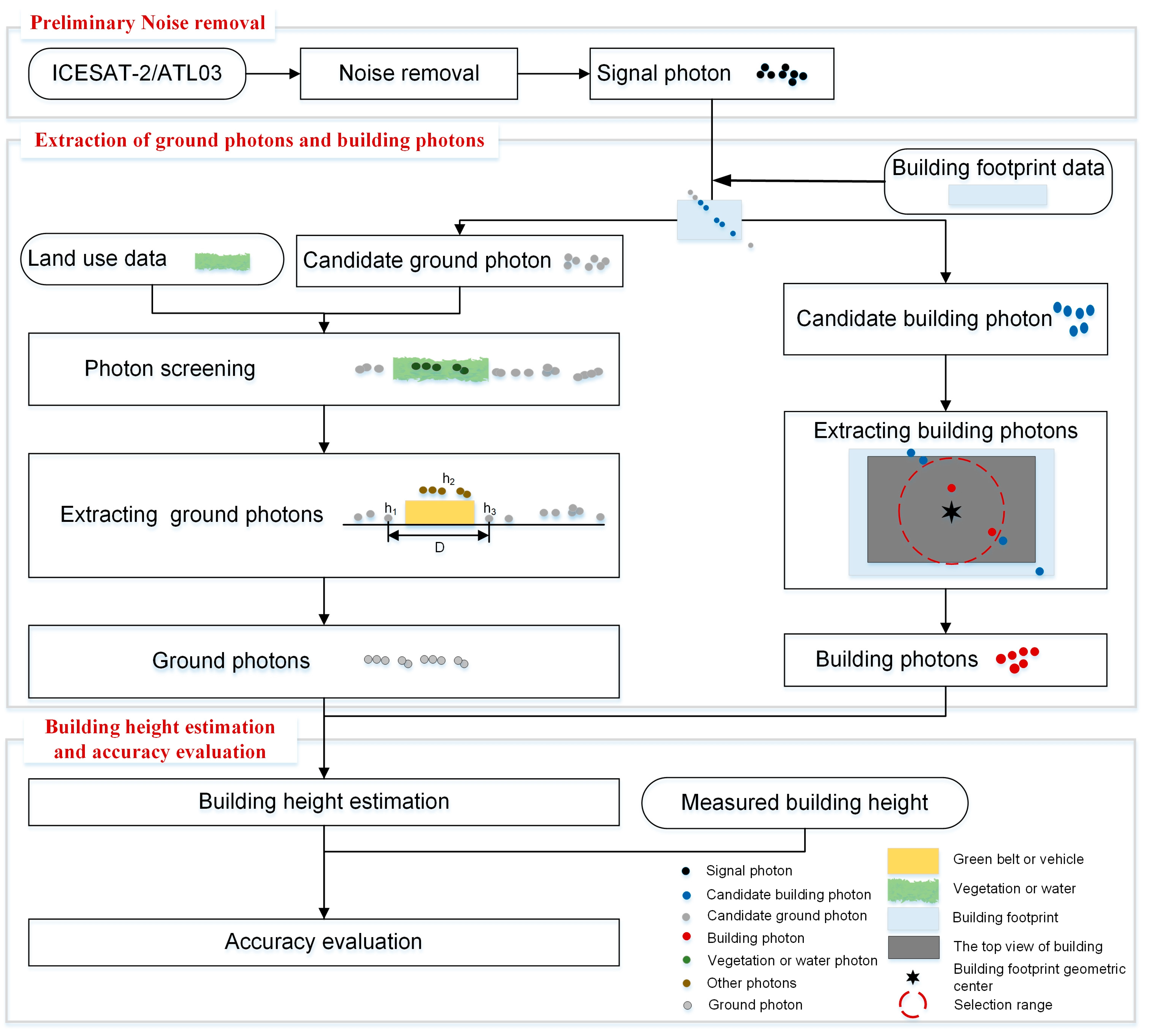





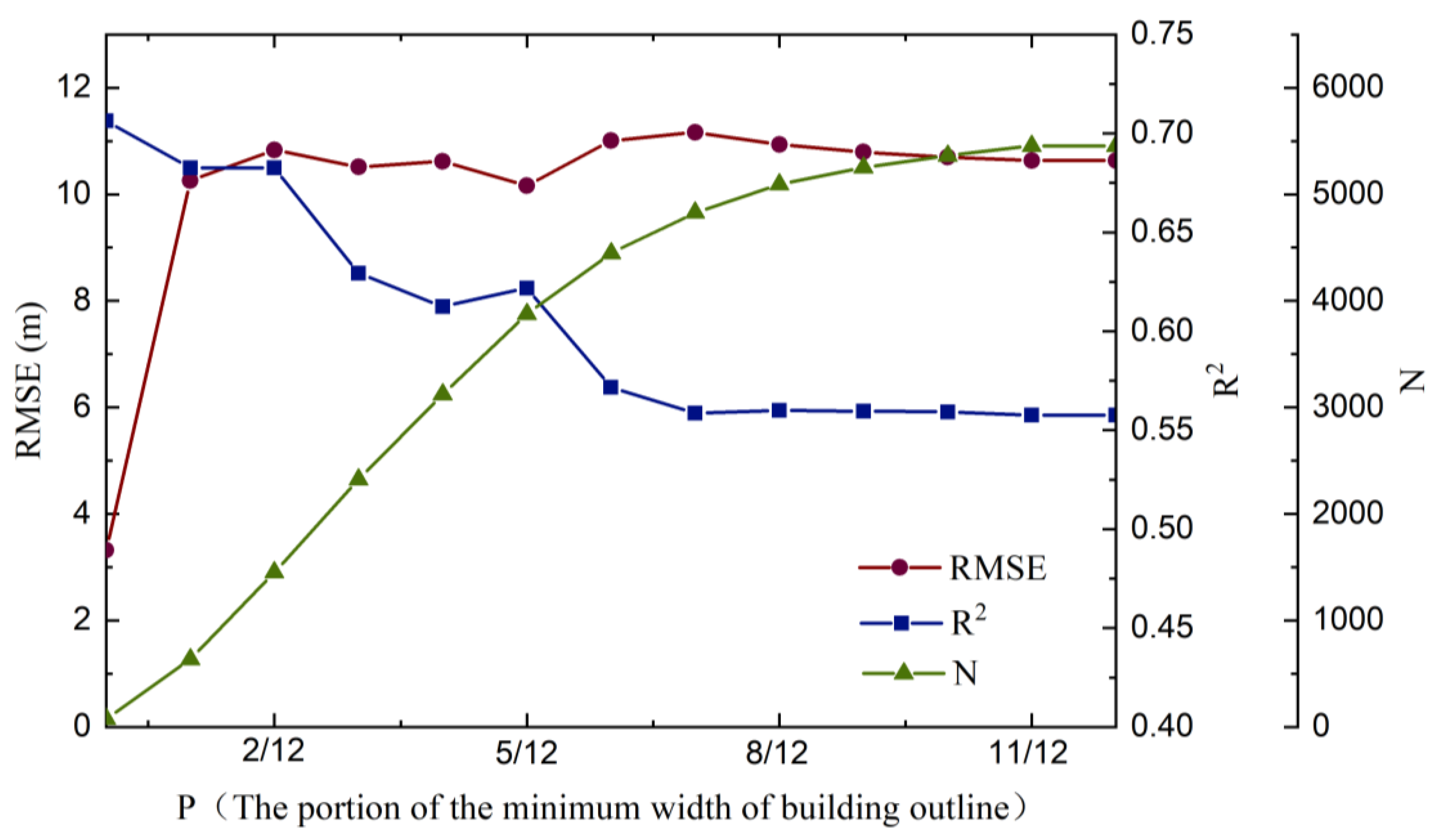
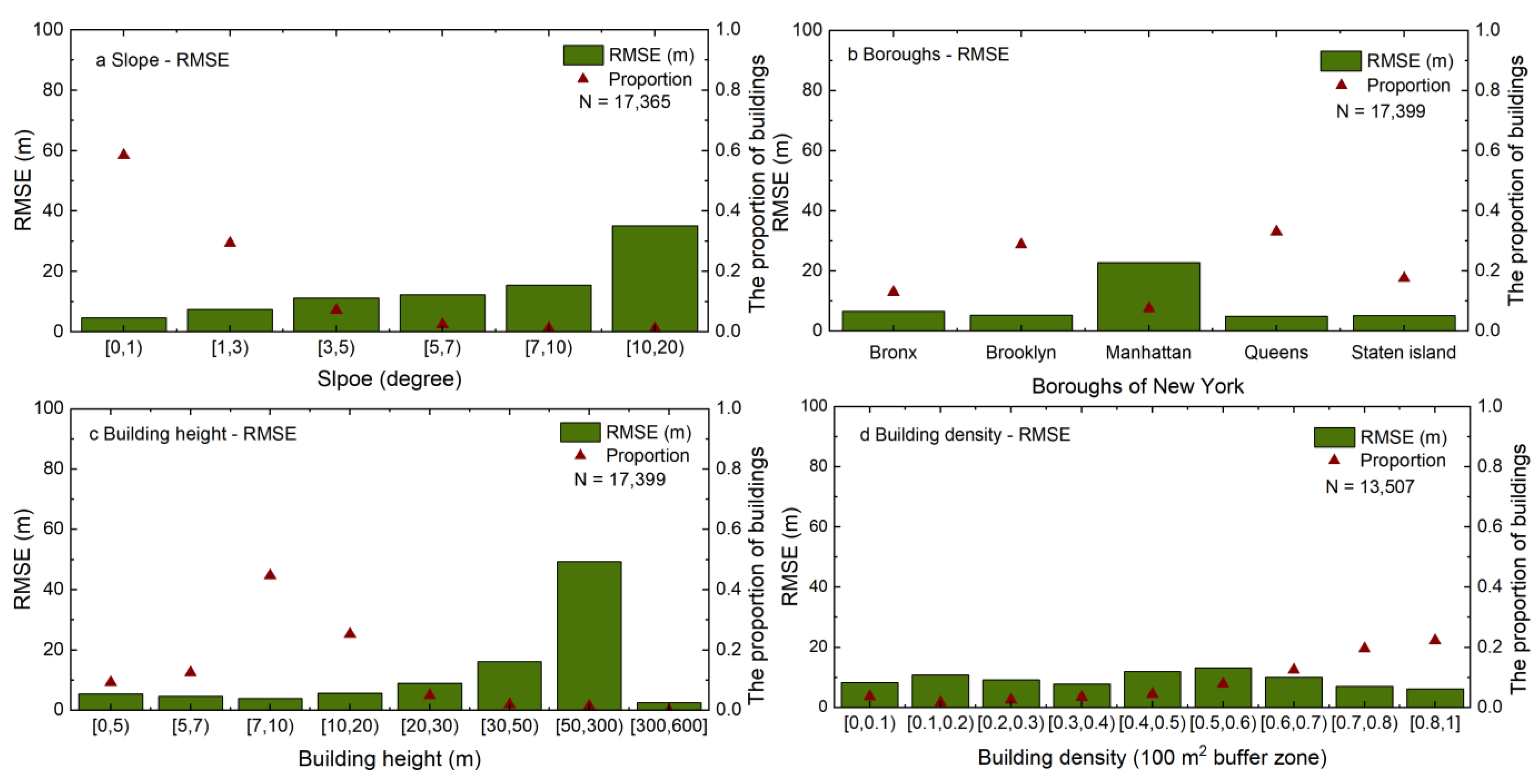
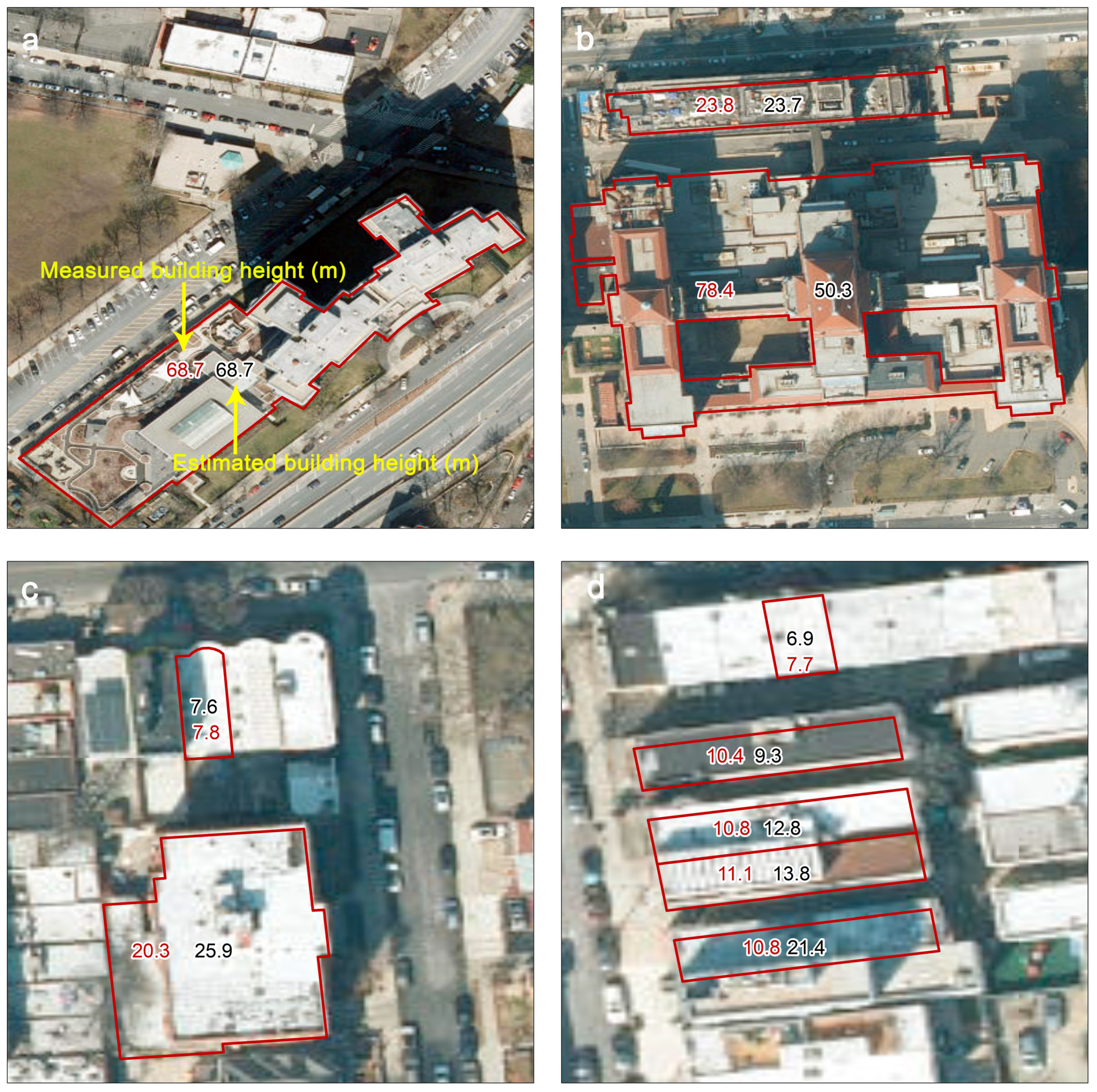
| h (m) (|∆Ht| and |∆Ht+n| > h) | m (m) (|∆H| < m) | d (m) (D < d) |
|---|---|---|
| 2 | 5 | 1000 |
| 2 | 7 | 1000 |
| 2 | 10 | 1000 |
| 2 | 13 | 1000 |
| 2 | 16 | 1000 |
| 3 | 5 | 1000 |
| 3 | 7 | 1000 |
| 3 | 10 | 1000 |
| 3 | 11 | 1000 |
| 3 | 13 | 1000 |
| 3 | 16 | 1000 |
| 4 | 10 | 1000 |
| 5 | 7 | 1000 |
| 5 | 10 | 1000 |
| 5 | 13 | 1000 |
| 5 | 16 | 1000 |
| h (m) (|∆Ht| and |∆Ht+n| > h) | m (m) (|∆H| < m) | d (m) (D < d) |
|---|---|---|
| hbest | mbest | 100 |
| hbest | mbest | 300 |
| hbest | mbest | 500 |
| hbest | mbest | 700 |
| hbest | mbest | 900 |
| hbest | mbest | 1000 |
| hbest | mbest | 1100 |
| hbest | mbest | 1300 |
| Variables | m | h | d | p | ||||
|---|---|---|---|---|---|---|---|---|
| ΔF | 33% | −33% | 30% | −30% | 30% | −30% | 33% | −33% |
| ΔRMSE | 2.20% | 0.80% | 1.40% | 2.20% | 1.00% | 2.40% | −0.60% | −3.50% |
| SAF | 0.07 | −0.02 | 0.05 | −0.07 | 0.03 | 0.08 | −0.02 | 0.11 |
| Building No. | Measured Building Height (m) | Estimated Building Height (m) | Absolute Error (m) | Relative Error (%) |
|---|---|---|---|---|
| 1 | 3 | 2.96 | 0.04 | 1 |
| 2 | 3 | 3.25 | −0.25 | 8 |
| 3 | 6 | 6.28 | −0.28 | 5 |
| 4 | 18 | 18.75 | −0.75 | 4 |
| 5 | 3 | 3.27 | −0.27 | 9 |
| 6 | 3 | 4.12 | −1.12 | 37 |
| 7 | 3 | 4.11 | −1.11 | 37 |
| 8 | 66 | 68.13 | −2.13 | 3 |
Disclaimer/Publisher’s Note: The statements, opinions and data contained in all publications are solely those of the individual author(s) and contributor(s) and not of MDPI and/or the editor(s). MDPI and/or the editor(s) disclaim responsibility for any injury to people or property resulting from any ideas, methods, instructions or products referred to in the content. |
© 2024 by the authors. Licensee MDPI, Basel, Switzerland. This article is an open access article distributed under the terms and conditions of the Creative Commons Attribution (CC BY) license (https://creativecommons.org/licenses/by/4.0/).
Share and Cite
Cai, P.; Guo, J.; Li, R.; Xiao, Z.; Fu, H.; Guo, T.; Zhang, X.; Li, Y.; Song, X. Automated Building Height Estimation Using Ice, Cloud, and Land Elevation Satellite 2 Light Detection and Ranging Data and Building Footprints. Remote Sens. 2024, 16, 263. https://doi.org/10.3390/rs16020263
Cai P, Guo J, Li R, Xiao Z, Fu H, Guo T, Zhang X, Li Y, Song X. Automated Building Height Estimation Using Ice, Cloud, and Land Elevation Satellite 2 Light Detection and Ranging Data and Building Footprints. Remote Sensing. 2024; 16(2):263. https://doi.org/10.3390/rs16020263
Chicago/Turabian StyleCai, Panli, Jingxian Guo, Runkui Li, Zhen Xiao, Haiyu Fu, Tongze Guo, Xiaoping Zhang, Yashuai Li, and Xianfeng Song. 2024. "Automated Building Height Estimation Using Ice, Cloud, and Land Elevation Satellite 2 Light Detection and Ranging Data and Building Footprints" Remote Sensing 16, no. 2: 263. https://doi.org/10.3390/rs16020263
APA StyleCai, P., Guo, J., Li, R., Xiao, Z., Fu, H., Guo, T., Zhang, X., Li, Y., & Song, X. (2024). Automated Building Height Estimation Using Ice, Cloud, and Land Elevation Satellite 2 Light Detection and Ranging Data and Building Footprints. Remote Sensing, 16(2), 263. https://doi.org/10.3390/rs16020263







